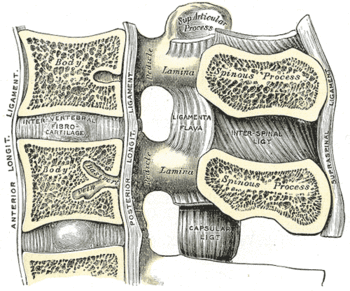Herniated disk
In medicine, a herniated disk is defined as an "intervertebral disk in which the nucleus pulposus has protruded through surrounding fibrocartilage. This occurs most frequently in the lower lumbar region.".[1]
A herniated disk is an infrequent, but important cause of low back pain. A herniated disk is more likely when sciatica is present.
Diagnosis
History and physical examination
| Finding | Sensitivity | Specificity |
|---|---|---|
| Sciatica | 95%[3] | 88%[3] |
| Straight leg raise | 92%[2] to 80%[3] | 28%[2] to 40%[3] |
| Crossed straight leg raise | 28%[2] | 95%[2] |
Testing
The role of magnetic resonance imaging is not clear.[4]
Treatment
Randomized controlled trials address discectomy (diskectomy) versus conservative care.[5] Microdiskectomy (with a microscope or loupe magnification) and open diskectomy are comparable according to a systematic review by the Cochrane Collaboration.[5]
The Spine Patient Outcomes Research Trial (SPORT) of 501 patients receiving an unstated mix of surgical procedures found "patients in both the surgery and the nonoperative treatment groups improved substantially over a 2-year period. Because of the large numbers of patients who crossed over in both directions, conclusions about the superiority or equivalence of the treatments are not warranted based on the intent-to-treat analysis."[6][7] The costs may be acceptable.[8]
Surgical results are better is surgery occurs within six months of the onset of symptoms.[9]
Microdiskectomy
Microdiskectomy uses unilateral transflaval approach with magnification provided by either a microscope or loupe. Some authors do not consider loupe magnification to be microdiskectomy. The Leiden-The Hague Spine Intervention Prognostic Study of 283 patients found that microdiskectomy led to quicker improvement at one year[10], with no further changes after two years.[11] The cost of surgery might be acceptable to some patients.[12]
Open diskectomy
The open diskectomy uses unilateral transflaval approach without magnification.
References
- ↑ National Library of Medicine. Intervertebral Disk Displacement. Retrieved on 2007-11-13.
- ↑ 2.0 2.1 2.2 2.3 2.4 van der Windt DA, Simons E, Riphagen II, Ammendolia C, Verhagen AP, Laslett M et al. (2010). "Physical examination for lumbar radiculopathy due to disc herniation in patients with low-back pain.". Cochrane Database Syst Rev 2: CD007431. DOI:10.1002/14651858.CD007431.pub2. PMID 20166095. Research Blogging.
- ↑ 3.0 3.1 3.2 3.3 3.4 Deyo RA, Rainville J, Kent DL (1992). "What can the history and physical examination tell us about low back pain?". JAMA 268 (6): 760–5. PMID 1386391. [e]
- ↑ Cohen SP, Gupta A, Strassels SA, Christo PJ, Erdek MA, Griffith SR et al. (2012). "Effect of MRI on treatment results or decision making in patients with lumbosacral radiculopathy referred for epidural steroid injections: a multicenter, randomized controlled trial.". Arch Intern Med 172 (2): 134-42. DOI:10.1001/archinternmed.2011.593. PMID 22157067. Research Blogging.
- ↑ 5.0 5.1 Gibson JN, Waddell G (2007). "Surgical interventions for lumbar disc prolapse". Cochrane Database Syst Rev (2): CD001350. DOI:10.1002/14651858.CD001350.pub4. PMID 17443505. Research Blogging.
- ↑ Weinstein JN, Tosteson TD, Lurie JD, et al (November 2006). "Surgical vs nonoperative treatment for lumbar disk herniation: the Spine Patient Outcomes Research Trial (SPORT): a randomized trial". JAMA : the journal of the American Medical Association 296 (20): 2441–50. DOI:10.1001/jama.296.20.2441. PMID 17119140. PMC 2553805. Research Blogging.
- ↑ Weinstein JN, Lurie JD, Tosteson TD, et al (November 2006). "Surgical vs nonoperative treatment for lumbar disk herniation: the Spine Patient Outcomes Research Trial (SPORT) observational cohort". JAMA : the journal of the American Medical Association 296 (20): 2451–9. DOI:10.1001/jama.296.20.2451. PMID 17119141. PMC 2562254. Research Blogging.
- ↑ Tosteson AN, Skinner JS, Tosteson TD, et al (September 2008). "The cost effectiveness of surgical versus nonoperative treatment for lumbar disc herniation over two years: evidence from the Spine Patient Outcomes Research Trial (SPORT)". Spine 33 (19): 2108–15. PMID 18777603. [e]
- ↑ Rihn JA, Hilibrand AS, Radcliff K, Kurd M, Lurie J, Blood E et al. (2011). "Duration of Symptoms Resulting from Lumbar Disc Herniation: Effect on Treatment Outcomes: Analysis of the Spine Patient Outcomes Research Trial (SPORT).". J Bone Joint Surg Am 93 (20): 1906-14. DOI:10.2106/JBJS.J.00878. PMID 22012528. Research Blogging.
- ↑ Peul WC, van Houwelingen HC, van den Hout WB, et al (May 2007). "Surgery versus prolonged conservative treatment for sciatica". The New England journal of medicine 356 (22): 2245–56. DOI:10.1056/NEJMoa064039. PMID 17538084. Research Blogging.
- ↑ Peul WC, Hout WB, Brand R, Thomeer RT, Koes BW; for the Leiden-The Hague Spine Intervention Prognostic Study Group. Prolonged conservative care versus early surgery in patients with sciatica caused by lumbar disc herniation: two year results of a randomised controlled trial. BMJ. 2008 May 23. PMID 18502911
- ↑ Hout WB, Peul WC, Koes BW, Brand R, Kievit J, Thomeer RT; for the Leiden-The Hague Spine Intervention Prognostic Study Group. Prolonged conservative care versus early surgery in patients with sciatica from lumbar disc herniation: cost utility analysis alongside a randomised controlled trial. BMJ. 2008 May 23. PMID 18502912
